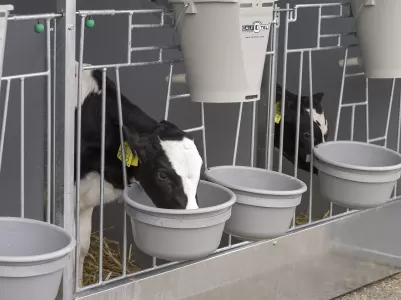More attention for calf housing
In recent years, more and more attention has been paid to how calves are fed. This is not surprising, considering that the care given to young calves will determine their performance as dairy cows in the future. Research has shown that intensive rearing of heifer calves improves their performance as dairy cows later in life. In light of this, it is a shame that suboptimal housing still hampers the genetic growth potential of calves on many farms.
What are we doing wrong when it comes to calf housing? Ensuring a clean, dry, and well-ventilated environment is the mainstay of good calf housing. This means that the infection rate must be kept to a minimum. Every avoidable infection takes its toll on young calves’ immune systems and has a negative effect on the young animals’ growth and development. These effects often go unnoticed, as the animal is not visibly ill. Good-quality housing and an appropriate hygiene protocol can prevent these avoidable infections and lower growth rates.
Where to house calves
The most basic method of ensuring good-quality calf housing is to look at the farm itself. Preferably, young calves should not be housed in the same area as older calves or dairy cows, so as to prevent the transmission of germs from older to younger animals. Another point of attention is how calf housing is cleaned and disinfected. Purchasing easy-to-clean boxes that are left empty for a while after cleaning ensures the very best results. This is easiest to achieve when calves are housed outside in igloos.
Research
This spring, vet Niels Groot Nibbelink from Veterinair Centrum Someren and Alana van Hees, a student at HAS University of Applied Sciences, conducted research on behalf of VDK Products into the cleaning and disinfecting of calf housing. The research revealed that calf housing is only truly ‘clean’ when both cleaned and disinfected. Read more about this research here.

Share this message

Agros Expo 2022
On January 25-27, Moscow will host the Agros Expo 2022 international exhibition of animal husbandry, breeding and forage production. We invite you to familiarize yourself with our bestsellers - Comfort and Open Top Premium calf hutches! Booth K36,...

In conversation with...
Filip and Anja from dairy farm De Brabander LV Filip (49) and Anja (47) De Brabander-Vandierendonck have enjoyed running a dairy farm with 260 dairy cows together in the municipality of Zomergem (Lievegem) Belgium for the past 27 years....

Reduce labour by up to 20% in the first four months
Investments in practical housing pay off. Calf rearing is a labour-intensive part of running a dairy farm. Proper calf rearing requires attention and care. Yet at many farms, it's possible to greatly reduce the amount of work. Labour savings...

More growth and health in outdoor housing
Thorough calf rearing is essential for a good performance as a dairy cow. With a high feeding regime and an all-in, all-out housing in small, fixed groups, calves perform best. This according to research by the Dutch Dairy Campus/WUR with 224...

Plastic versus Polyester
Choice of materials determines lifespan. Calf hutches made from plastic or polyester: What will you choose? At first glance, they might seem similar. Yet there is a world of difference. Arjan Harbers, Sales Manager at VDK Agri,...

VDK Agri Open Top Premium wins Innov’SPACE!
VDK Agri has won a 2020 Innov’SPACE for the Open Top Premium Single and Duo! Our colleague Jean Bernard Béranger received the award yesterday.

New products!
VDK Agri launches not one but three new products, among which a new line for indoor accommodation. These calf pens are suitable for dairy farmers who want to keep calves indoors or under a roof. The products were developed on the basis of the latest...

Cleaning calf hutches an easy job with CleanPro foaming product
A calf is continuously surrounded by micro-organisms. Only a few of those are true ‘pathogen’ and can, therefore, cause diseases. In order to keep these pathogens away, we aim for the highest possible level of hygiene. ...
